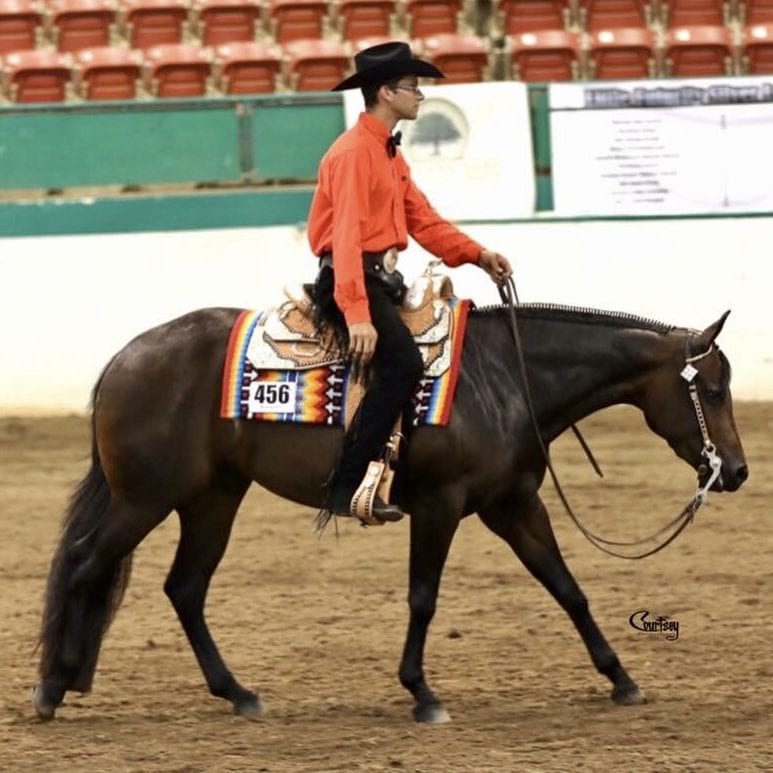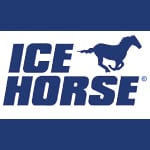This time of year always brings new excitement as breeders, owners, trainers, and exhibitors are gearing up toward showcasing their newest stock. The two and three-year-old western pleasure and hunter under saddle futurity classes provide some of the most lucrative and name-making competition.
But training and showing a baby takes more than skill; often it is a combination of correct timing, patience and a little bit of luck.
We spoke with some of the industry’s leading futurity trainers, Karen Hornick, Cole Baker, Aaron Moses, and Shane Pope about how they get a youngster ready to show.
Few Will Make It
Not every two-year-old started each year will make it to the show pen, and in fact, very few, in comparison to the number of horses saddle broke each year, actually do. Picking which ones will be conditioned towards competition isn’t as easy as choosing the biggest of the group. Multiple futurity and AQHA Congress winner, Karen Hornick of Jamestown, Ohio explains, “It is not so much that we pick who will make it to show and who won’t, but rather they [the horse] will tell you.”
Owners and breeders may have high hopes, but a good trainer will let the horse speak for itself. Aaron Moses Show Horses may be a newly opened business located in Collinsville, Texas but his success with futurity horses is already well documented.
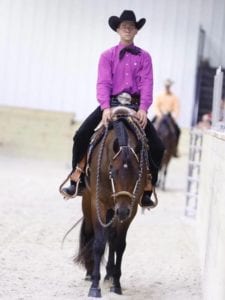 With wins at the 2017 The Madness and Little Futurity, Aaron (pictured right) is now preparing for the Tom Powers. As far as picking which babies will graduate to the show pen and which will have to wait, he states, “I don’t think of it so much as culling the herd. The good horses will rise to the top themselves. I start all my horses the same. I ride them all the same unless they are too small or weak. The ones that are going to make it to the futurities or the Congress are going to show you. They make it obvious, and if you are lucky, you’ll only have to make a decision between a few.”
With wins at the 2017 The Madness and Little Futurity, Aaron (pictured right) is now preparing for the Tom Powers. As far as picking which babies will graduate to the show pen and which will have to wait, he states, “I don’t think of it so much as culling the herd. The good horses will rise to the top themselves. I start all my horses the same. I ride them all the same unless they are too small or weak. The ones that are going to make it to the futurities or the Congress are going to show you. They make it obvious, and if you are lucky, you’ll only have to make a decision between a few.”
Shane Pope, multiple futurity and Congress Champion of Conway, South Carolina agrees. His business focuses mainly on creating winning western pleasure horses starting as longe-liners to three-year-olds. He adds, “During the spring, the two-year-olds start separating themselves. Some come out every day and just want to learn. Others take more time and progress slower. I feel that most horses need to go through the complete process and then determine what level they can be competitive. I believe that futurity horses are born, not made.”
What They Look for
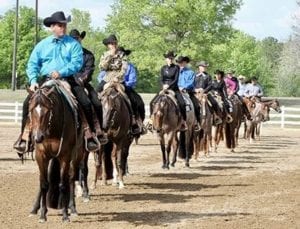 So, if the horses are the ones who show the trainers when they are ready for competition, what is it that these top talents are looking for? How do they start preparing the prospective winners for the show ring? Another winner of multiple futurities and money earner, Cole Baker of Dunnellon, Florida (pictured left at the front of the line) shares his insight.
So, if the horses are the ones who show the trainers when they are ready for competition, what is it that these top talents are looking for? How do they start preparing the prospective winners for the show ring? Another winner of multiple futurities and money earner, Cole Baker of Dunnellon, Florida (pictured left at the front of the line) shares his insight.
“As a rule of thumb for me, if by Memorial Day weekend, I can’t put my hands down and ride around, I don’t think I am going to be ready,” Baker says. “I always consider the horse’s strength and mental maturity to make my decision if one is going to be an early two, late two, or have to wait until its three-year-old year to show. If I have one that is working to potential, I take that last month to work on transitions, fine tuning and keeping them all healthy.”
Similarly, Moses usually has the notion of when a horse will be ready to show a month before its first outing in the show pen. He clarifies, “It all depends on the horse. I have a good idea a month before, but sometimes I won’t know until the week before if a colt is going to show. A month before they should have a good grasp of what I want. They may not be polished yet.”
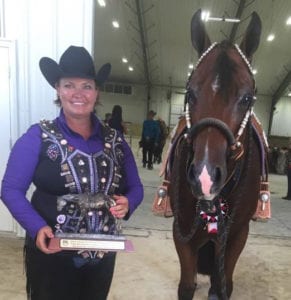 Hornick (pictured right) looks for a horse that is starting to do it on their own. “About a month out, I want to be able to turn them loose and have them maintain their self-carriage. A good one will be able to do that. I like them to be able to keep the same frame with little help about this time.”
Hornick (pictured right) looks for a horse that is starting to do it on their own. “About a month out, I want to be able to turn them loose and have them maintain their self-carriage. A good one will be able to do that. I like them to be able to keep the same frame with little help about this time.”
Shane Pope agrees, “I think a two-year-old should have all of the education needed several weeks out from the show. The last few weeks should just be repetition, reinforcement, and lots of transitions. The transitions are very important. They need to be soft and correct before I feel we’re ready.”
Take Them on The Road
Consensus between all these trainers is that to get one ready, they have to have experience, and that means going on the road. Hornick describes, “We have been taking our prospects on the road. It is so good for their training. All the distractions, if they can keep the same rhythm and same step at home and at the horse show, they will be that much farther ahead.”
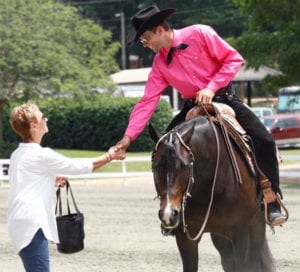 Moses explains how distractions can be an asset to training futurity prospects. “The sooner I can get one ready, by responding to my feet, by it learning to stay, by it knowing where it needs to be, the better. From there, I can help it gain confidence so it can handle being in an awkward spot, better. And when a horse has confidence, that’s where you get that cool look.”
Moses explains how distractions can be an asset to training futurity prospects. “The sooner I can get one ready, by responding to my feet, by it learning to stay, by it knowing where it needs to be, the better. From there, I can help it gain confidence so it can handle being in an awkward spot, better. And when a horse has confidence, that’s where you get that cool look.”
Baker uses traveling to train at horse shows as a gauge to perfect his show day routine that will occur at big futurities. “You need time to find the perfect routine, and that can be hard with two-year-olds. I try and ride them at the same time of day that they are going to be shown. I need to figure out which ones need to be longed and how much. Some will tire quicker. You have to find the balance between getting them ready to show and getting them too tired. Unlike when you have a seasoned show horse, you know how they are going to respond. With two-year-olds, you have to learn from them.”
Why Futurities are Necessary
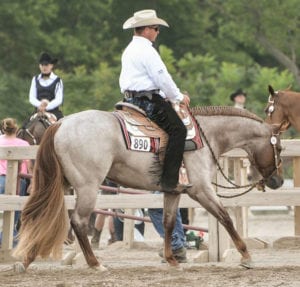 Often the drive-by social media condemns two-year-old futurity classes. However, these award-winning, hardworking, and dedicated horsemen and horsewomen stand up for the necessity of futurities.
Often the drive-by social media condemns two-year-old futurity classes. However, these award-winning, hardworking, and dedicated horsemen and horsewomen stand up for the necessity of futurities.
“The two and three-year-old futurities are important for several reasons. It gives the owner and breeder a chance to showcase their stock, and it puts a great foundation on the horse which will allow him to do multiple events in the future,” Pope states. “It also allows the trainer to demonstrate their abilities and hard work. Without the two and three-year-old futurities, there would be a huge deficiency of broke horses in our industry.”
Hornick adds, “We put endless hours into all the horses we start, whether they make it as two-year-old show horses or not. Good trainers know when to push and know when to wait. The majority of trainers out there are responsible and ethical. Pleasure is the basis of where all the other classes start. Without that methodical balance, rhythms and step, horses would not be able to go on and do other things. Not all horses will make it as show [pleasure] horses, but they all need to be properly trained in the event before they can learn anything else, like a lead change.”
Cole Baker wholehearted agrees almost to the exact wording, “It is the base of every class we have. It is where every class starts, where all good horses start. If you find a good five or six-year-old that hasn’t been broke or hasn’t been shown, likely there is a good reason for that. Horses in other classes nowadays are so much better movers and so much better broke than in the past. We need to take advantage of their age and athleticism that has been acquired by good, modern breeding.”
About the Author – An AQHA Professional Horseman, Mo West currently lives in Danville, California. Assistant trainer at Busick Quarter horses, she enjoys training and coaching. Fishing is her second favorite activity and she always has her beloved dog, Crash, at her side whenever possible.


